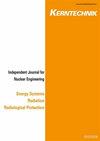重离子束辐照含泡沫球形燃料囊聚变反应堆沉积能量增益的建模与仿真
IF 0.4
4区 工程技术
Q4 NUCLEAR SCIENCE & TECHNOLOGY
引用次数: 0
摘要
摘要在采用惯性约束聚变(ICF)方法进行重离子聚变时,重离子在靶体中的沉积能量和燃料囊内等离子体中聚变反应产生的带电产物是关键和必要的点。本文采用ICF方法模拟了一个装有多层泡沫燃料胶囊的球形聚变反应堆堆芯,采用辐射能量分别为8 GeV和10 GeV的两束Cs和Pb重离子束从32个不同方向对称照射。在此基础上,利用GEANT4程序模拟了光束在堆芯内的穿透和能量沉积过程。我们的模拟结果表明,随着辐射光束原子序数的增加,束流阻止功率的增加,这与现有理论一致。此外,通过改变辐射束的类型和能量、厚度、所选燃料囊层的材料类型等参数,穿透深度的数量、产生的二次粒子、燃料囊和反应堆堆芯的单位体积停止功率也会发生变化。最终,这些变化将导致球形聚变反应堆核心内沉积能量增益的变化。与D3He和P11B两种无中子燃料相比,本研究中8 GeV和10 GeV两束选择性Pb+和Cs+获得的最大沉积能量与DT燃料有关。可以看出,当束流能量从8 GeV变化到10 GeV时,能量增益显著增加,但对于所选的两种能量,DT的能量增益相比D3He和P11B的增强并不明显。本文章由计算机程序翻译,如有差异,请以英文原文为准。
Modeling and simulation of deposited energy gain via irradiation of heavy ion beams on the fusion reactor contains spherical fuel capsules with foam
Abstract In heavy ion fusion using the inertial confinement fusion (ICF) approach, firstly, the deposited energy of heavy ions in the target and, secondly, the charged products resulting from fusion reactions in the plasma of the fuel capsule are key and necessary points. In this paper, we used the ICF method for the core of a spherical fusion reactor simulation filled with multi-layer fuel capsules with foam using symmetrical irradiation from 32 different directions by two heavy ion beams of Cs and Pb with radiation energies of 8 and 10 GeV, respectively. Then we simulated the process of penetration and deposited energy of the beams inside the core of this reactor using GEANT4 code. The results of our simulations show that if the atomic number of radiation beams increases, the amount of beam stopping power increases, which is in agreement with existing theories. Also, by changing parameters such as the type and energy amount of the radiation beam, thickness, and the type of material selected in the layers of the desired fuel capsules, the amount of the penetration depth, the produced secondary particles, the stopping power per unit volume of fuel capsule and the reactor core will change. Eventually, these variations will cause a change in deposited energy gain inside the core of a spherical fusion reactor. The obtained maximum deposited energy due to the two selective Pb+ and Cs+ beams with 8 and 10 GeV energies in this study is related to DT fuel compared to the two neutron free-fuels of D3He and P11B. It can be seen that energy gain increases significantly with changing beam energy from 8 to 10 GeV, but for both selected energy, the enhancement of DT energy gain compared to D3He and P11B is not so significant.
求助全文
通过发布文献求助,成功后即可免费获取论文全文。
去求助
来源期刊

Kerntechnik
工程技术-核科学技术
CiteScore
0.90
自引率
20.00%
发文量
72
审稿时长
6-12 weeks
期刊介绍:
Kerntechnik is an independent journal for nuclear engineering (including design, operation, safety and economics of nuclear power stations, research reactors and simulators), energy systems, radiation (ionizing radiation in industry, medicine and research) and radiological protection (biological effects of ionizing radiation, the system of protection for occupational, medical and public exposures, the assessment of doses, operational protection and safety programs, management of radioactive wastes, decommissioning and regulatory requirements).
 求助内容:
求助内容: 应助结果提醒方式:
应助结果提醒方式:


